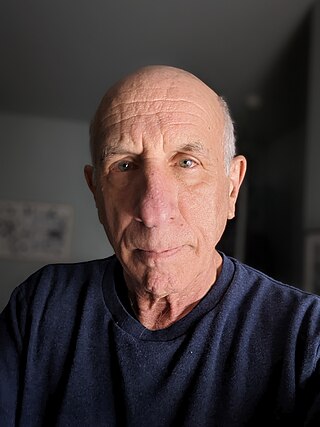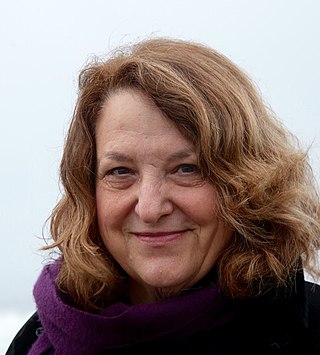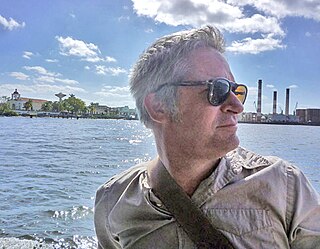Related Research Articles

Kenneth Feingold is a contemporary American artist based in New York City. He has been exhibiting his work in video, drawing, film, sculpture, photography, and installations since 1974. He has received a Guggenheim Fellowship (2004) and a Rockefeller Foundation Media Arts Fellowship (2003) and has taught at Princeton University and Cooper Union for the Advancement of Art and Science, among others. His works have been shown at the Museum of Modern Art, NY; Centre Georges Pompidou, Paris; Tate Liverpool, the Whitney Museum of American Art, New York, among others.
Tony Oursler is an American multimedia and installation artist married to Jacqueline Humphries. He completed a Bachelor of Fine Arts at the California Institute for the Arts, Valencia, California, in 1979. His art covers a range of mediums, working with video, sculpture, installation, performance, and painting. He lives and works in New York City.

Lynn Hershman Leeson is a multimedia American artist and filmmaker. Her work combines art with social commentary, particularly on the relationship between people and technology. Leeson is a pioneer in new media, and her work with technology and in media-based practices helped legitimize digital art forms. Her interests include feminism, race, surveillance, and artificial intelligence and identity theft through algorithms and data tracking. She has been referred to as a "new media pioneer" for the prescient incorporation of new science and technologies in her work. She is based in San Francisco, California.

José Braulio Bedia Valdés is a Cuban painter currently residing in Florida.
David Kenneth Ireland was an American sculptor, conceptual artist and Minimalist architect.
New Langton Arts was a not-for-profit arts organization focusing on contemporary art founded in 1975 and located the South of Market neighborhood in San Francisco, California. Part of the first wave of alternative art spaces in the United States, and New Langton Arts was a leader in exhibiting new media forms in art and involving artists in the decision-making process. Its first directors were Judy Moran and Renny Pritikin.
The history of art in the San Francisco Bay Area includes major contributions to contemporary art, including Abstract Expressionism. The area is known for its cross-disciplinary artists like Bruce Conner, Bruce Nauman, and Peter Voulkos as well as a large number of non-profit alternative art spaces. San Francisco Bay Area Visual Arts has undergone many permutations paralleling innovation and hybridity in literature and theater.
Peter d'Agostino is an artist and a professor of Film and Media Arts, Temple University, Philadelphia.

Felipe Dulzaides is a Cuban-born American contemporary artist. His practice includes installation, photography, video, drawing, sculpture and performance. Two important cities of reference of his works are San Francisco, California and Havana, Cuba.
Guy Overfelt is an American multi-disciplinary post-conceptual artist. He works with various media including sculpture, performance, photography, video and drawing. He is based in San Francisco and Bolinas, California.
Brett Reichman is an American painter and educator. He was a professor at the San Francisco Art Institute where he taught both in the graduate and undergraduate programs. His work came to fruition in the late 1980s out of cultural activism that addressed the AIDS epidemic and gay identity politics and was curated into early exhibitions that acknowledged those formative issues. These exhibitions included Situation: Perspectives on Work by Lesbian and Gay Artists at New Langton Arts in San Francisco, The Anti-Masculine at the Kim Light Gallery in Los Angeles, Beyond Loss at the Washington Project for the Arts in Washington, D.C, and In A Different Light: Visual Culture, Sexual Identity, Queer Practice at the Berkeley Art Museum, Berkeley, California. However, after legislation passed in 1989 that restricted federal funding for art dealing with homosexuality and AIDS, artists like Reichman approached their themes subtly. His And the Spell Was Broken Somewhere Over the Rainbow is embellished with colors of the rainbow and presents three clocks. It references Oz while actually indirectly addressing the new reality that San Francisco could no longer be viewed as a land of enchantment due to the AIDS crisis. Born in Pittsburgh, Pennsylvania, he has lived and worked in San Francisco since 1984.
Anglim Trimble Gallery, formerly Gallery Paule Anglim, and Anglim Gilbert Gallery, is a contemporary commercial art gallery which is located at Minnesota Street Project, 1275 Minnesota Street, San Francisco, California The gallery was founded by Paule Anglim in the early 1970s.

J. John Priola is a San Francisco-based contemporary visual artist and educator. He is known for photographic series capturing humble, generally inanimate subjects that explore human presence, absence and loss through visual metaphor. Priola's mature work can be broadly divided into earlier black-and-white, gelatin-silver series—formal elegant, painterly works largely focused on everyday objects and architectural details elevated to portraits—and later color series, which gradually shifted from architectural settings to detailed, varied explorations of the often-conflicted human relationship to nature. San Francisco Chronicle critic Kenneth Baker situated Priola's images "on the border between documentary and conceptual art," where they function as surveys of under-noticed details that "remind us how many potential questions, how much intimate domestic history, may lie embedded on the margins of our attention."

Raúl Cordero is a Cuban born conceptual painter. First known as part of the 90s generation in Cuba, when he started exhibiting his work mostly in Europe and the United States of America. Cordero represents through his work the "other Cuban art." Far from the standards of the Cuban Revolution art, and without falling into topics of other artists from in and out of the island, Cordero samples pretexts whimsically obtained from various referential origins and shows us his work as a result of recycling, of a revival, creating a new reality that refers more to art than to any other apparent content.
Miguel Ángel Rojas is a Colombian conceptual artist born in Bogotá in 1946. His work includes drawing, painting, photography, installations and video and is often related to the sexuality, the marginal culture, the violence and problems involved with drug consumption and production.
John Zurier is an American abstract painter, known for his minimal, near-monochrome paintings. His work has shown across the United States as well as in Europe and Japan. He has worked in Reykjavik, Iceland and Berkeley, California. Zurier lives in Berkeley, California.
Taravat Talepasand is an American contemporary artist, activist, and educator, of Iranian descent. She is known for her interdisciplinary painting practice including drawing, sculpture and installation. As an Iranian-American woman, Talepasand explores the cultural taboos that reflect on gender and political authority. Her approach to representation and figuration reflects the cross-pollination, or lack thereof, in our Western Society. Talepasand previously held the title of the chair of the painting department at San Francisco Art Institute (SFAI). She is an assistant professor in art practice at Portland State University.
Frank Gillette is an American video and installation artist. Interested in the empirical observation of natural phenomena, his early work integrated the viewer's image with prerecorded information. He has been described as a "pioneer in video research [...] with an almost scientific attention for taxonomies and descriptions of ecological systems and environments". His seminal work Wipe Cycle –co-produced with Ira Schneider in 1968– is considered one of the first video installations in art history. Gillette and Schneider exhibited this early "sculptural video installation" in TV as a Creative Medium, the first show in the United States devoted to Video Art. In October 1969, Frank Gillette and Michael Shamberg founded the Raindance Corporation, a "media think-tank [...] that embraced video as an alternative form of cultural communication.
Gay Outlaw is an American artist working in sculpture, photography and printmaking. She is known for her "rigorous and unexpected explorations of material". She is based in San Francisco, California.
Shalom Gorewitz is an American visual artist. Gorewitz was among the first generation of artists who used early video technology as an expressive medium. Since the late 1960s, he has created videos that "transform recorded reality through an expressionistic manipulation of images and sound". His artworks often "confront the political conflicts, personal losses, and spiritual rituals of contemporary life". Gorewitz has also made documentary and narrative films.
References
- ↑ "Tony Labat: Left Jab". Berkeley Art Museum and Pacific Film Archive (BAMPFA). 2005. Retrieved 2017-03-31.
- ↑ "Tony Labat". Electronic Arts Intermix (EAI). Retrieved 2017-03-31.
- ↑ Anreus, Alejandro; Greeley, Robin Adèle; Sullivan, Megan A. (2021-10-26). A Companion to Modern and Contemporary Latin American and Latina/o Art. John Wiley & Sons. p. 432. ISBN 978-1-118-47539-3.
- ↑ Baker, Kenneth (2005-10-08). "Conceptual artists who pack a wallop". SFGate. Retrieved 2020-06-27.
- ↑ "Gladstone Gallery, New York". re-title.com Features. Retrieved 2020-06-27.
- ↑ "Tony Labat. Lost in the Translation. 1984". The Museum of Modern Art (MoMA). Retrieved 2020-06-27.
- ↑ Lauzon, Claudette (2017-04-24). The Unmaking of Home in Contemporary Art. University of Toronto Press. ISBN 978-1-4426-2159-6.
- ↑ "Tony Labat: I WANT YOU". SFMOMA. Retrieved 2020-06-27.
- ↑ "Ñ (enn-yay), Tony Labat". Electronic Arts Intermix (EAI). Retrieved 2020-06-27.
- ↑ Novakow, Anna (1998). "Carnal pleasures: Desire, public space and contemporary art".
- ↑ Artists' Video: An International Guide. Cross River Press. 1991. ISBN 9781558593572.
- ↑ Ayres, Anne (1986). 2nd Newport Biennial: The Bay Area. Newport Harbor Art Museum. ISBN 9780917493072.
- ↑ Damian, Carol (1997). Breaking Barriers: Selections from the Museum of Art's Permanent Contemporary Cuban Collection. Art Museum Fort Lauderdale. Art Museum Fort Lauderdale.
- ↑ "Art Papers Magazine". 2006.
- ↑ "Bay Area Now Two". 1999.
- 1 2 Hainley, Bruce (January 2006). "Tony Labat, New Langton Arts". Artforum, Vol. 44, No. 5. Retrieved 2023-09-12.
- ↑ "San Francisco Art Institute's Tower As Video Canvas". San Francisco News. 2020-08-31. Retrieved 2023-09-12.
- ↑ "Tony Labat". MoMA.
- ↑ "Tony Labat". Centre Pompidou. Retrieved 2023-09-12.
- ↑ "Tony Labat". OCMA Collections. Retrieved 2023-09-12.
- ↑ "Tony Labat | Anglim Gilbert Gallery". anglimgilbertgallery.com. Retrieved 2017-03-31.
- ↑ "BOMB Magazine — Vale La Pena: The 11th Havana Biennial by Liz Munsell". bombmagazine.org. Retrieved 2017-03-31.
- ↑ "Tony Labat: Four Installations". The Museum of Contemporary Art, Los Angeles. Retrieved 2017-03-31.